The Phenom II X4 810 & X3 720: AMD Gets DDR3 But Doesn't Need It
by Anand Lal Shimpi on February 9, 2009 12:00 AM EST- Posted in
- CPUs
Overclocking-
Since all of the new AM3 parts are built off of the same Phenom II die as what we reviewed back in January, we'd expect similar overclocking results. While I worked on performance testing, Gary went to work on overclocking these new Socket-AM3 CPUs. What follows are his first experiences.
We are utilizing the ASUS M4A78T-E motherboard based on the AMD790FX/SB750 chipset for our overclocking tests, this is actually a Socket-AM3 motherboard. The Phenom II X4 810 and X3 720 BE processors are meant for the mid-range market and users are likely to pair them with the 790GX chipset or something similar. We will have additional overclocking results in the near future comparing various AM3 and AM2+ boards along with lower priced components. Our AM3 board selection currently includes the ASUS M4A79T Deluxe (790FX/SB750), ASUS M4A78T-E, and the ASRock M3A790GXH/128M, which upholds their ability to provide high HTT rates for locked processors on the 790GX chipset. We expect additional AM3 boards from MSI, Gigabyte, and others shortly.
We put an emphasis on stability during our testing sessions so we test with real world applications ranging from a variety of games to digital imaging software to various audio/video creation programs, along with the normal OCCT and PCMark Vantage tests. We focus on the type of overclocks that support 24/7 operation with reasonable cooling and the ability to run a multitude of programs without a problem. We are not optimizing for SuperPI or 3DMark records; it's more like trying to keep our bank records safe from a crash (sadly, there's nothing we can do about actual banks crashing).
Overclocking Test Setup
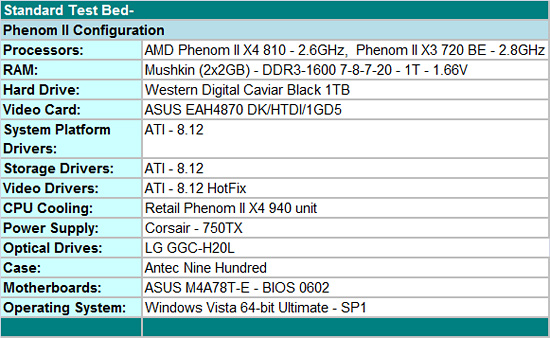
We selected the ASUS EAH4870 DK/HTDI/1GD5 video card for GPU duties. It is a non-reference design that offers improved thermals and acoustics over the standard HD4870 1GB cards in our board choices. The WD Caviar Black 1TB is the hard drive of choice for storage purposes. LG’s GGC-H20L Blu-ray drive fills in for optical duties. Our power supply is Corsair’s 750TX that we used in a couple of recent P45 and Phenom II CrossFire articles. The reason for this is to ensure similar power consumption numbers in our motherboard articles this year. However, in the IG centric motherboard tests we will show additional results with the Thermaltake TR2-430W power supply.
We selected Mushkin’s impressive DDR3-1600 kit to ensure our systems would not be limited by memory speed. We used 4GB in our standard benchmarks with memory set at DDR3-1600 with 7-8-7-18 timings at 1.66V. We will also test with some budget friendly DDR3-1333 from Patriot in the individual motherboard reviews. Our cooling choice is the retail unit from a Phenom II X4 940 as our engineering samples were not shipped with a heatsink/fan. Our clock speeds did not change with improved CPU air-cooling in today's test. However, temps did drop anywhere from 6C~9C at load with the Vigor Monsoon III LT we tested and would highly recommend utilizing an upgraded air cooler for the long term. We utilized Antec’s Nine Hundred case, yes, it is overkill for our uATX boards but we wanted to provide excellent cooling for our setups during overclocking for these particular tests.
Phenom II X3 720 BE Maximum Overclock on Stock Voltages
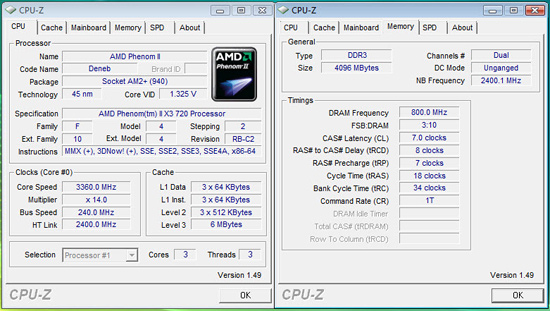
Our maximum overclock on stock Core VID with the X3 720 BE resulted in a 3.36GHz clock speed at a respectable 240HTT clock and Northbridge speed at 2400MHz. Memory speed is set to DDR3-1600 at 7-8-7-18 1T on 1.68V, slightly higher than our stock 1.66V for additional stability in Crysis Warhead. The primary voltages settings were left at auto in the BIOS with it determining a 1.3375V CPU/NB voltage. We tried a variety of CPU multipliers and HTT clock speed and still ended up around 3.3GHz as our maximum clock at the stock Core VID of 1.325V.
Phenom II X3 720 BE Maximum CPU/HTT Overclock
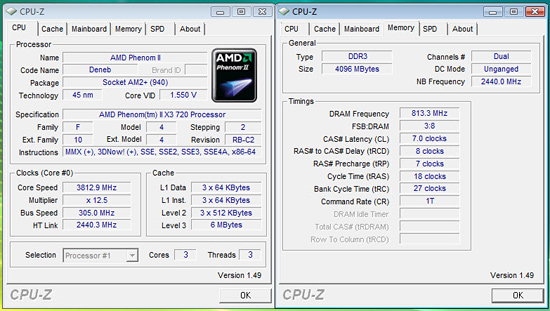
Our maximum overclock for both CPU and HTT speed ended up at a 12.5x305HTT setting. This resulted in a 3.812GHz processor clock speed with Northbridge speed at 2440MHz. We initially set our Northbridge speed to 2745MHz but could not hold stability in several of our benchmarks, regardless of voltage settings. We set Core VID to 1.55V, VDimm to 1.68V, CPU/NB Voltage to 1.4375V, and HT to 1.38V. Memory speed is set to DDR3-1627 at 7-8-7-18 1T. Our best performing and highest CPU/HTT setting was at 13x300 for a 3.90GHz core speed, but we could not hold stability in Crysis Warhead, Cyberlink Power Director 7, or the Movie/TV test in PCMark Vantage x64.
Phenom II X3 720 BE Maximum CPU Overclock
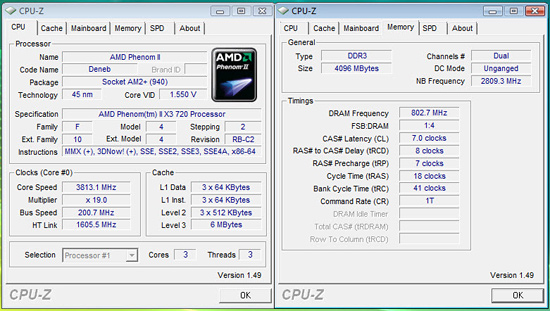
No surprises here based on our results above. Our maximum overclock for both CPU speed ended up at a 19x200HTT setting. This resulted in a 3.813GHz processor clock speed with Northbridge speed at 2809MHz. We set our Core VID to 1.55V, VDimm to 1.66V, CPU/NB Voltage to 1.4375V, and HT to 1.38V. on stock VCore with the X3 720 BE resulted in a 3.36GHz clock speed at a respectable 240HTT clock and Northbridge speed at 2400MHz. Memory speed is set to DDR3-1600 at 7-8-7-18 1T. We also tried the 19.5x200HTT setting for 3.90GHz, but could not hold stability in the applications mentioned above. The system would post at 20x200 easily, but Vista 64 SP1 would always BSOD once entering the OS. It appears from all indications that the AM3 processors have the same 4GHz limitation in Vista 64 with normal cooling methods. We increased VCore to 1.60V and could POST at 4.2GHz but could never enter the OS regardless of other NB speed, HT speed, or voltage settings.
Phenom II X4 810 Maximum Overclock on Stock Voltages
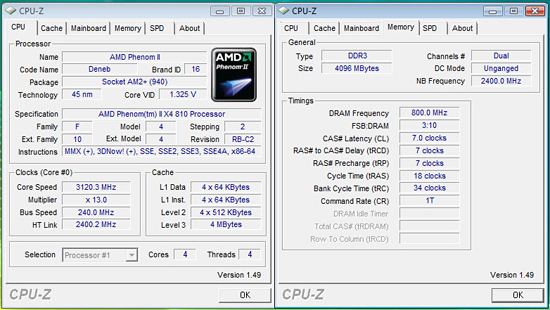
Our top overclock on stock VCore with the X4 810 resulted in a 3.12GHz clock speed at a healthy 240HTT clock and Northbridge speed at 2400MHz. Memory speed is set to DDR3-1600 at 7-7-7-18 1T on 1.66V. We left the primary voltages settings at auto in the BIOS with it determining a rather high 1.3750V CPU/NB voltage. We found through trial and error that a CPU/NB voltage of 1.3325 was stable at this clock speed. Since this CPU is locked, we could not increase the CPU multiplier but did try a variety of lower multipliers and higher HTT clock settings. However, on a stock Core VID and without greatly reducing memory speeds, our final 240HTT clock setting was the best we could accomplish.
Phenom II X4 810 Maximum CPU Overclock
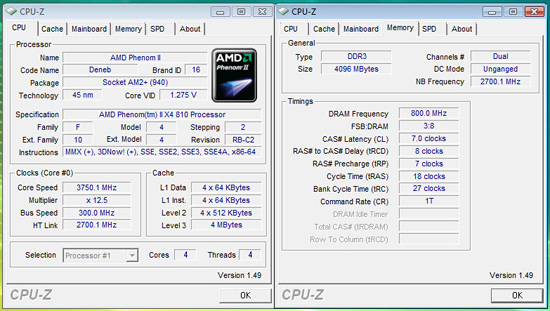
Our maximum overclock on the X4 810 ended with an offbeat 12.5x300HTT setting. This resulted in a 3.75GHz processor clock speed with Northbridge speed at 2700MHz. We tested a variety of combinations and this one resulted in our best CPU speed and overall system performance. We just could not go higher regardless of voltages or HT/Northbridge settings and keep the system stable. We almost had 13x295HTT stable at 3.83GHz but it would consistently fail most of our encoding benchmarks. We set Core VID to 1.55V, VDimm to 1.66V, CPU/NB Voltage to 1.4250V, and HT to 1.38V. One strange item we noticed is that our various reporting tools except TurboV from ASUS would show Core VID fluctuating wildly from 1.455V to 1.62V depending on the application. We checked with our DMM and voltage was at 1.571V on our 1.55V setting. Memory speed is set to DDR3-1600 at 7-8-7-18 1T. We also tossed in our new Corsair Dominator GT DDR3-2000 C7 kit for fun and had an easy time running 5-6-5-18 1T timings at DDR3-1600 with 1.62V on this board.

































77 Comments
View All Comments
zagortenay - Wednesday, February 11, 2009 - link
When you click that Intel logo on the left hand side, Anandtech becomes an Intel site. Only a fool beleives Anandtech is promoting Intel for free and I beleive the cunning Intel gets what she pays for.Hey Anand this is not acceptable! Hey Anand do you hear me!
swaaye - Thursday, February 12, 2009 - link
I've always thought Anand was more of an AMD guy, going by how he names his AMD and ATI reviews. :)swaaye - Tuesday, February 10, 2009 - link
Phenom doesn't really need much bandwidth to do its thing for most applications.http://ixbtlabs.com/articles3/cpu/amd-phenom-x4-98...">http://ixbtlabs.com/articles3/cpu/amd-phenom-x4-98...
starx5 - Tuesday, February 10, 2009 - link
I can see intel logo on the 1eft of this site.You must independent from intel's hand.
I know Core i7 is totally jerk in gaming.
starx5 - Tuesday, February 10, 2009 - link
I think anandtech is intel's doll.refer to this reviews
http://www.overclockersclub.com/reviews/phenomii_7...">http://www.overclockersclub.com/reviews/phenomii_7...
http://www.tomshardware.com/reviews/socket-am3-phe...">http://www.tomshardware.com/reviews/socket-am3-phe...
http://www.guru3d.com/article/amd-phenom-ii-x4-810...">http://www.guru3d.com/article/amd-phenom-ii-x4-810...
http://www.guru3d.com/article/amd-phenom-ii-x4-920...">http://www.guru3d.com/article/amd-phenom-ii-x4-920...
Core i7 is absolutely a gaming failer!!
goinginstyle - Friday, February 13, 2009 - link
I think it is more of a case of those sites listed being an utter failure at proper benchmarking.jchan2 - Tuesday, February 10, 2009 - link
Interesting.... I wonder whats up with that?7Enigma - Wednesday, February 11, 2009 - link
They also kind of contradict their own article later on saying:"Benchmark note:
We moved towards a new 64-bit environment for all our test. This entailed new software updates for our benchmarks plus we replaced a lot of our tests with different software. This means that if you compare the results published in this review with other processor reviews from Guru3D.com, the numbers might not add anymore up due to different software and tests."
So unless they reran an Intel system using 64-bit software I don't know where the data came from for the i7 and E8400 platforms?
7Enigma - Wednesday, February 11, 2009 - link
Possibly even more weird in the Guru3D article is the test system only had 2 gigs of ram?!? That just seems crazy even with Vista 32-bit. You can easily get some system oddness. I mean heck, 4gig should be the MINIMUM in a review of new hardware. I can't tell if that would help or hurt, but it should definitely add another layer of complexity to figuring out what means what in this article.7Enigma - Wednesday, February 11, 2009 - link
Seems like (in the OC'ers club review) they were GPU limited or at least entering the compression range in the majority of circumstances. They used a GTX 260 (216) which is definitely a bit underpowered for the latest generation of CPU's. Most of their graphics settings are too high once they get above 1024X768 to see a large difference in frame rates. Yes you can say they are still all playable, but it makes seeing the actual power of the CPU less important.Guru3d article again is weird. The biggest problem I see here is what the test setup is for the Intel i7 system? I skimmed the article (it's huge), but never could find it. As for the testing again heavily GPU-limited over about 1280X1024 (and in some cases literally right off the bat at 1024X768). Once they hit 1600X1200 with the single 280 the cpu's have just stalled waiting for the GPU. This still doesn't explain the Crysis: Warhead numbers which show the i7 LOWER than the AMD cpu's @ 1600X1200. My guess is the percent error in the testing is large and so pretty much anything within 5% is equal (again denoting the GPU-bottleneck).
I won't comment on Tom's as that site has lost all respect with me.
But we've all known that gaming performance with the latest (or even previous generation CPU's) when not also using CF/SLI or stupidly low resolutions DOES NOT make a huge difference with most games (some RTS/FlightSim/FarCry2/etc. excluded). decided to try that way back with Conroe to show how it wasn't so great for gaming (testing everything under completely GPU-limited scenarios).
This isn't news.